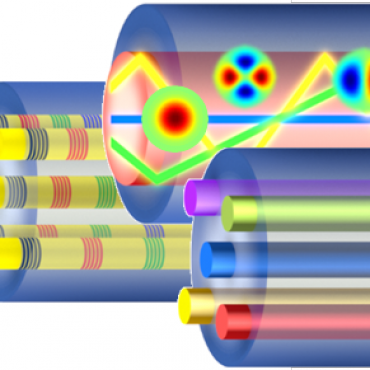The increasing number of mobile devices and advanced multimedia applications combined with the worldwide adoption of social media has led to an exponential growth in mobile data traffic at a global level, where emerging applications and services such as Smart City, Smart Buildings, Factories of Future, Intelligent Transportation Systems, Smart Grid and the Internet of Things will play a significant role beyond voice and data services for users.
The Photonics Research Labs group currently works towards addressing these challenges by using different technologies:
- Optical OFDM access networks
The exponential growth of traffic in long-haul, metropolitan and access networks leads to an increase of bandwidth which can be met by using advanced modulation techniques. Optical Orthogonal Frequency Division Multiplexing (OOFDM) signal transmission, due to its high spectral efficiency and its advantages for overcoming dispersion transmission impairments, has attracted a large number of researchers during the last years due to the amount of wireless and wireline standards currently using the OFDM modulation technique.
The Photonics Research Labs group has a large number of papers on the optimization of OOFDM signal transmission networks and current experimental work is driven towards the demonstration of more efficient networks in terms of costs and power consumption, as well as providing dynamic bandwidth assignment in WDM-OOFDM centralized architectures. Flexible and low cost OOFDM fiber access networks including Optical Wireless Communications links in hybrid deployments are under current development in this lab.
- Er/Yb advanced amplifiers for distribution networks
The use of WDM channels in telecommunication optical networks requires the use of amplifiers in a broader spectral band, so efforts are currently addressed to obtain flat amplification over the extended spectrum around 1550nm. In the current market, Er/Yb fibers provide high performance amplifiers in the 1550nm band for applications such as LIDAR, CATV, FTTx, OWC, etc.
The Photonics Research Labs group is currently developing optimized structures employing double- and triple-clad fiber for current optical access networks where high optical output power (> 30dBm) is required, as well as a reduced noise figure ( 6dB), minimum required pumping power (5W) and reduced distortion (CSO and CTB <-65 dB).
- WDM over polymer optical fiber networks
During the last 25 years POFs have attracted the attention due to their advantages compared to the coaxial cable for high speed data communication systems in the short distance data and communication networks apart from applications in other fields such as lighting, biomedical or sensing. Compared to silica fibers, POF offers a reduced product of bandwidth and channel length, but the tight alignment, lower bending tolerance, difficulty to handle and higher installations costs of the formers make the polymer fibers an interesting transmission media to implement optical systems. The recent adveniment of new CYTOP material leads to polymer fibers with reduced losses up to 2dB/m caused a surge of interest on POF systems towards the increase of capacity while QoS is assured in current and future services.
In the Photonics Research Labs, we currently work on the development of WDM technology over POF for high capacity local area networks, data center interconnections (onboard or intraboard) or automotive WDM networks.

Publications
- Sánchez, B. Ortega, J. Capmany, “OFDM-IDMA for uplink transmission in passive optical networks,” IEEE Photonics Journal, vol. 4, No. 4, pp. 1-13 (2012).
- Zheng, C. Sánchez, B. Ortega and J. M. Tang, “Compensation of directly modulated DFB laser frequency chirps in optical OFDM IMDD PON systems,” IET Optoelectronics, Vol.6, No.2, pp.75-81 (2012).
- Sánchez, B. Ortega, J.L.Wei, J.M. Tang, J. Capmany, “Analytical formulation of directly modulated OOFDM signals transmitted over an IM/DD dispersive link”, OSA Optics Express, vol. 21, pp. 7651-7666 (2013).
- Sánchez, B. Ortega, J.L.Wei, J. Capmany, “Comprehensive impairment and performance description of directly modulated/detected OOFDM systems”, IEEE Journal of Lightwave Technology, vol. 31, pp. 3277-3288 (2013)
- Sánchez, B. Ortega, J.L.Wei, J. Capmany, “Optical filtering in directly modulated/detected OOFDM systems”, OSA Optics Express, vol. 21, pp. 30591-30609 (2013).
- Sanchez, B. Ortega, and J. Capmany, “System performance enhancement with pre-distorted OOFDM signal waveforms in DM/DD systems”, Optics Express, vol. 22, pp. 7269-7283 (2014).
- I. Chicharro, B.Ortega, J.Mora, “Paired SSB optical OFDM channels for high spectral efficient signal transmission over DWDM networks”, Optics Communications, 370, pp. 239-244 (2016).
- Sáez-Rodríguez, K.Nielsen, O.Bang, B.Ortega, “Compact multichannel demultiplexer for WDM-POF networks based on spatially overlapped FBGs”, Electronics Letters, vol. 52, pp. 635-637 (2016).
- Sáez-Rodríguez, R.Min, B.Ortega, K.Nielsen, D.J.Webb, “Passive and portable polymer optical fibre cleaver”, IEEE Photonics Technology Letters, vol. 28, pp. 2834 – 2837, DOI: 10.1109/LPT.2016.2623419 (2016).
- I. Chicharro, B.Ortega, M. de Diego, J.Mora, “OOFDM signal transmission using a single broadband source”, IEEE Photonics Technology Letters, accepted (2017).









